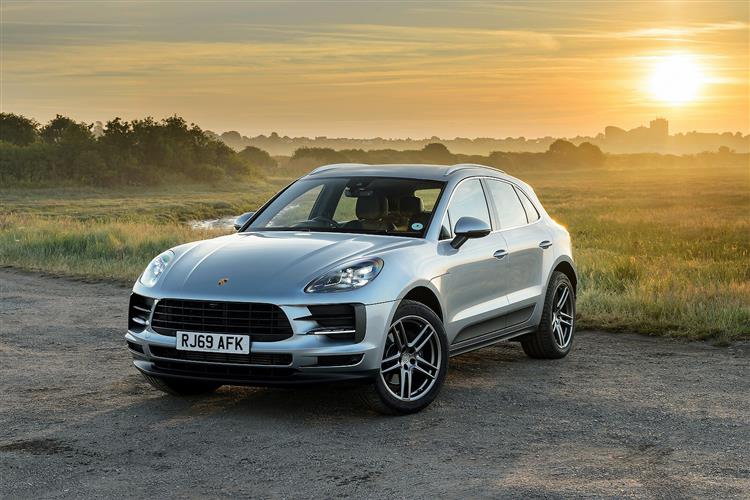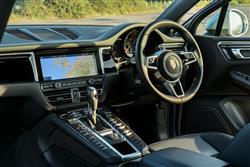How will you view?
This is a sample, and will stop after 30 seconds.
MAKE IT A MACAN (some text hidden) SECTIONED_new_porschemacan_2019
By Jonathan Crouch
Introductionword count: 107
The Macan is the Peoples' Porsche. The model to convert the SUV cynics. And an SUV with the soul - and the engineering - or a sports car. Here's the version updated in 2018, which sold until another update in 2021. You might expect it to be fast and family-friendly. More of a surprise is that it's rewarding and, with the right spec, very nearly race-ready in its responses. Yet it'll comfortably take you off road, deal with the school run and cruise down to Chamonix. It sets the ultimate benchmark for just how dynamic the handling of an SUV can be. And it's very special indeed.
Modelsword count: 12
(2.0, 3.0, 2.9 petrol - Macan, Macan S, Macan GTS, Macan Turbo)
Historyword count: 573
Lots of unlikely models have been described as 'sports cars' over the years. It's always been hard though, to imagine an SUV in that way. Or at least it was until the launch of this model, the Porsche Macan, in 2014. This car re-defined the way an SUV could drive and four years into its production cycle, the Zuffenhausen maker substantially upgraded it to create the contender we're going to look at here. Over 350,000 Macans had been sold by the time this improved model arrived in the Autumn of 2018, tasked with continuing a success story that saw the original version account for nearly half of its maker's entire sales volume in our market. But that was quite an ask given that this facelifted range lacked the diesel engine that had previously accounted for over 40% of the Macan's European sales mix. Nor was that void filled by a Plug-in hybrid variant, as it was in period in the larger Cayenne model's line-up. Instead, in an all-petrol range, the old entry-level ex-Golf GTI 2.0-litre turbo unit was moved to centre stage. Slotting in below two freshly added V6s, a 3.0-litre unit borrowed from the Cayenne and a 2.9-litre twin-turbo borrowed from top Audi RS models for the potent Macan Turbo. Otherwise here, the updates were subtle - minor styling changes, upgraded cabin infotainment, a range of fresh options and a series of dynamic tweaks aimed at further underlining this contender's claim to be 'the sports car of the SUV segment'. Of all brands, Porsche should know just what a claim that is to make about a model that weighs nearly two tonnes, is over 1.6m in height and must be engineered to tackle the Rubicon Trail as well as the racetrack. If you've driven the company's larger Cayenne SUV, you'll know that an awful lot is possible with this kind of car - but inevitably, there are always limits. With the Macan, Porsche was always determined to stretch them and create the ultimate multi-tasker. A car as ready for a circuit as it would be for a skiing trip, classy enough for the streets of Monte Carlo, soundly sensible on the school run, quietly capable on the rough stuff and potentially manic around Monza. The company's certainly well-placed to create such a thing, claiming the whole 'sporting all-wheel drive car' concept as its own invention. Back in 1900, Ferdinand Porsche designed the Lohner-Porsche racing model with its four electric wheelhub motors. By 1947, the brand was going further, developing a supercharged 12 cylinder 'Type 360' Cisitalia Grand Prix racer that introduced the concept of full four-wheel drive. For all that though, the Stuttgart maker had never made a car quite like this prior to this model line's original arrival in 2014. Perhaps that's why at the beginning of Macan development, it initially turned to Volkswagen Group partner Audi with the early idea of basing this car on that company's similarly-sized Q5. It wasn't long into the development process though, before Porsche decided it knew better. It alone could create the kind of mid-sized sporting SUV that models like the Q5, Range Rover's Evoque and the BMW X4 could never be. So almost everything was re-invented. Almost everything was re-imagined. Almost everything was different. As, in this post-2018 form, this car still was from just about everything else in its segment. It sold in this form until a further minor update in 2021.
What You Getword count: 357
You'd really need to see pre and post-2018-era Macan models together to appreciate the changes made to this updated model, but actually there were plenty, perhaps the most significant one being the adoption of sleeker full-LED headlights which incorporated the four-LED 'ice cube'-style design motif that's characteristically Porsche. The ribbed corner cut-outs remained, but they were re-designed with more overtly vertical outer frames. Not much was changed in profile, apart from re-styled wheels which vary in size from 18 to 21-inches. It's the rear perspective that most clearly identifies this as an updated version of stylist Michael Mauer's original design, thanks to the adoption of the kind of smart three-part LED light panel that characterises the brand's more recent models. The whole 'soul of a sports car' thing might be a difficult concept to swallow from the outside, but you feel it keenly at the wheel, thanks to the way the low-set seat and this high centre console create such a 'cockpit'-style feel. As with the original model, it features peerless build quality and great ergonomics. Changes made to this revised version included the adoption of a much larger and more sophisticated 'Porsche Communications Management' centre-dash touchscreen, which included online navigation, 4G LTE 'phone compatibility, 'Apple CarPlay' and a 10-speaker DAB audio system. This monitor's bigger 10.9-inch size required a re-design for the central vents, but its installation wasn't accompanied by a change to an all-digital instrument cluster. So the Macan continued with a classic three instrument-tube binnacle layout, the right hand pod incorporating a screen that could bring navigation mapping more directly into your line of sight. In the rear, three adults can certainly fit for short-to-medium journeys, provided the unfortunate middle seat occupant doesn't mind splaying their legs around the extremely high centre transmission tunnel. Out back, the standard automatically-operable rear tailgate rises to reveal a 500-litre cargo bay. If you need to take longer items, you'll be glad that the rear backrest folds in a useful 40:20:40-split, which means you can poke through things like skis without disturbing rear seat passengers. Push the rear bench completely forward and a 1,500-litre capacity is freed up.
To see the full road test text contact us on 0330 0020 227
Pictures (high res disabled)

.jpg)
|
.jpg)
|
.jpg)
| |||
.jpg)
|
.jpg)
|

|
Scoring (subset of scores)
Category: Crossover or SUV 4x4s
| Performance | |
| Handling | |
| Comfort | |
| Space | |
| Styling, Build, Value, Equipment, Depreciation, Handling, Insurance and Total scores are available with our full data feed. | |



